Pleyel pianos
In more than two centuries, Pleyel has shown its permanent ambition to innovate and reinvent itself, from a technical and aesthetic perspective, in order to meet the wishes of the most demanding musicians. The Maison Pleyel has always accompanied the greatest performers and composers throughout the ages.
"When I feel in good form and strong enough to find my own sound, I need a Pleyel piano", Chopin liked to repeat.
Pleyel pianos, celebrated by numerous awards and other prizes, are recognized for their many innovations that have allowed the evolution of this beautiful instrument. A pioneer to its soul, the Maison Pleyel symbolizes the French genius of instrumental craftsmanship.
The story of Pleyel in video
A legendary brand
Many historical celebrities have contributed to the legend of this prestigious brand : composers, writers, painters, architects, entrepreneurs, politicians, high dignitaries, aristocrats... To mention only the first of them...
Frédéric Chopin - César Franck - Charles Gounod - Frédéric & Arthur Kalkbrenner - Claude Debussy - Edvard Grieg - Jules Massenet - Georges Bizet - Maurice Ravel - Giacomo Meyerbeer - Jacques Ibert - Gioacchino Rossini - Félix Mendelssohn - Arthur Rubinstein - Camille Saint-Saëns - Richard Strauss - Jacques Offenbach - Johann Baptist Cramer - Ignaz Moscheles - Alfred Cortot - Marguerite Long - Maupassant's family - George Sand - Eugène Scribe - Sergueï Rachmaninov - Nikolaï Rimski-Korsakov - Wanda Landowska - Comtesse de Ségur - Alexis de Tocqueville - Léon Tolstoï - Ivan Tourgueniev - Eugène Delacroix - Henri Matisse - Pierre-Auguste Renoir - Puvis de Chavannes family - Ary Scheffer - Horace Vernet - Viollet-Le-Duc - De Dietrich - Henry Lemoine - Isaac Pereire -Ferdinand de Lesseps - Cognac Hennessy - Cognac Martell - Champagne Moët - Louis Roederer - De Rothschild's family - Madame Récamier - Victor Schoelcher - Maréchal Exelmans - Prince de Clermont-Tonnerre - Patrice de Mac-Mahon - Comte Charles de Flahaut (Aide-de-camp to
Napoleon) - Letizia Bonaparte (Napoleon's mother) - Jérôme Bonaparte (Napoleon's brother) - Prince Pierre d’Arenberg - Prince François Borghèse - Duchesse de Crillon - Prince Victor de Broglie - Napoléon Joseph Ney (Prince of the Moskowa) - Jules de Polignac (Prince of the Holy-Empire) - Prince Klemens de Metternich - Anna Pavlovna de Russie (Queen of the Netherlands) - Dom Pedro Ier (Emperor of Brazil and King of Portugal) - Ferdinand-Philippe d’Orléans (Crown Prince of France) - Isabelle II d’Espagne (Queen of Spain) - Wilhelmine de Prusse (Queen of Holland) - Elena Pavlovna de Russie (Imperial Majesty) - Louis-Philippe (King of the French)...

Pleyel Romantica model
The Beautiful Story from 1807 to the present day
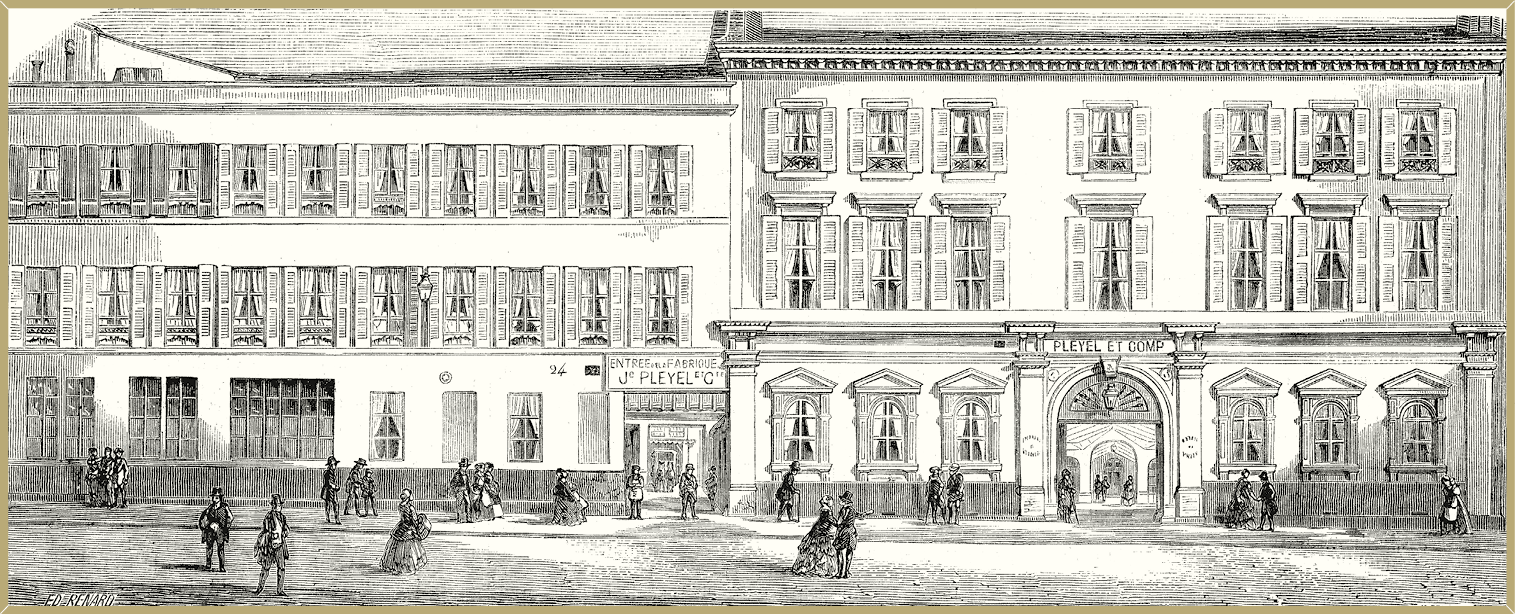
The founder
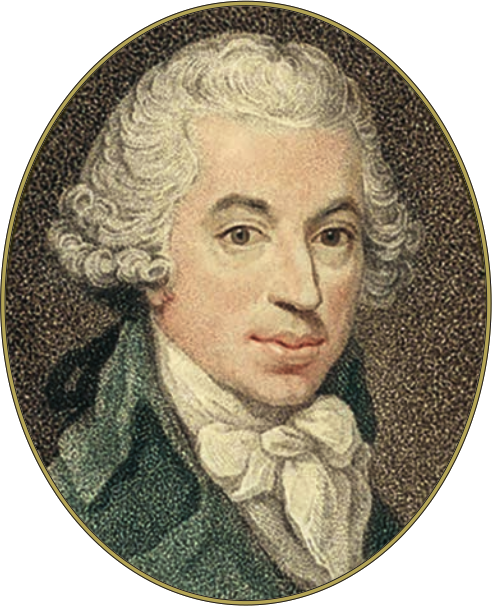
A musician and a talented composer
Even though the name of Pleyel is known worldwide today, few people know who is behind this legendary name in music. Ignaz Pleyel was born June 18th 1757 in Ruppersthal in Lower Austria. A teacher’s son, the young man was very soon noticed for his musical skills by Count Ladislaus Erdöly who became his patron. He took prestigious lessons and became the favourite pupil of Joseph Haydn. With the support of his patron, Ignaz Pleyel made many trips to Europe where he was to meet the main actors in musical life at that time.
In 1783, Ignaz Pleyel arrived in Strasbourg where he took charge of the Prince of Rohan Music School and then in 1789 became the master of the Strasbourg Cathedral orchestra. By accepting this departure for France, the musician obtained the right of "Bourgeoisie" allowing him to become a French citizen and change his name to Ignace.
Mozart : "What a joy for music"
During the last 15 years of the 18th century, Ignace Pleyel was the most popular and most played musician; his talent was greatly appreciated by his colleagues, the first of whom was Mozart, who said about Pleyel: "What a joy for music."
Crowning this reputation, Pleyel played a series of concerts in London in 1792 with his master Joseph Haydn. Both were virtuosos at the height of their art. While the French Revolution was in full swing, the best French artists were asked to celebrate this new era of liberty, equality and fraternity.
Thus, Ignace Pleyel composed the Hymn to Freedom in 1791 and The Revolution of August 10th in 1793. And while the revolutionary composers were appointed as teachers at the new Conservatory, Ignace preferred to settle with his family in the neighbourhood of the Chaussée d’Antin in Paris, where he founded a music publishing house.
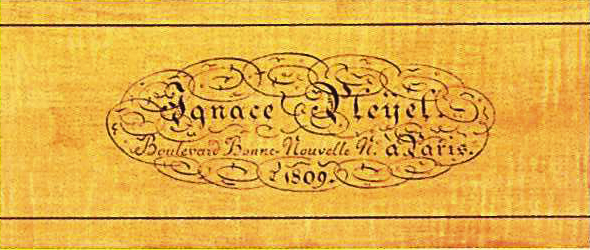
on a square piano of 1809

A talent at the service of his art
In 1797, Ignace opened a small music publishing house in Paris. Naturally he began by publishing his own works, but also those of Haydn, Mozart, Beethoven and Boccherini.
Brimming with ideas, it was not long before he invented the paperback score. His cost-effective collection in paperback format was called the "Music Library". Fashion changes in music pushed Ignace Pleyel to shelve his playing career to devote himself to his publishing business.
However he soon expanded his activities, launching into the sale of various instruments, including harps, guitars and pianos.
1807, the first Pleyel pianos
To manufacturing his own pianos, Ignace Pleyel teamed up with Charles Lemme, who owned a workshop in Paris. This partnership only lasted a short time, a mere three years, before Pleyel set up his own workshop at the end of 1807. Increasingly absorbed by his piano manufacturing workshop, he gave up his publishing house in 1809. Unfortunately for Ignace Pleyel, the sale of instruments went through a major crisis shortly afterwards and he struggled to sell his instruments.
Without the financial help of his musician friends, such as Kalkbrenner, Rossini and Mehul, Pleyel pianos would have had an extremely short existence. In 1824, his son Camille joined him to take over all his sales activities. Ignace Pleyel gradually moved away from musical life and retired to his Somereau home near Paris.
A dynasty of musicians

Camille Pleyel, a musician who amazed Chopin
Born in 1788 in Strasbourg, Camille Pleyel first studied with his father before receiving lessons from virtuoso Jan Ladislav Dussek.
A talented musician and concert performer, Camille made numerous trips through Europe and was particularly noticed in the court of the King of England. Less prolific than his father in terms of composition, Camille was nevertheless a better musician.
Moreover, his friend Frédéric Chopin said about him, "today, there is only one man who can play Mozart, and that is (Camille) Pleyel, and when he wants to play a four-hand sonata with me, I take a lesson."
A new boost for Pleyel pianos
In 1824, at the age of 35, Camille joined his father in the adventure of Pleyel pianos. Camille had taken advantage of his many trips to visit piano manufacturers, such as Broadwood, and he was inspired to improve his own pianos. The arrival of Camille was thus the herald of an in-depth reorganisation of the company, which quickly paid off. Indeed, as of 1825, his research and innovative work allowed the company to expand.
But Camille had another important asset: his connections and friendly relations with the great musicians of the time. Kalkbrenner, who had already helped his father, became his partner in 1824, while other artists like Cramer, Moscheles or Chopin promoted the brand worldwide. Thus, soon after his arrival, the company boomed and acquired an international reputation.
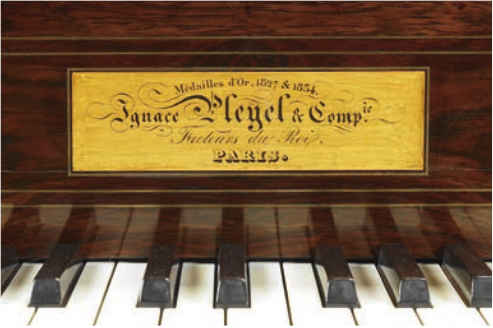
in the 19 th Century
One obsession: improve his instruments
Led by passionate musicians, the Pleyel Company has always interacted with the artists of its time by associating them with its innovations. Often at the forefront, they have become classics. By 1825, the Pleyel father and son team filed a patent for the manufacture of "unichord pianos" (one string per note instead of the usual two or three).
In 1827, they presented their pianos at the Paris National Exhibition and were awarded a gold medal. They then became the official piano manufacturers of Louis Philippe, Duke of Orleans and future King of French.
The following innovations came thick and fast: development of the soundboard brace attachments to overcome the inconveniences of wooden frames, patent in 1828 of a soundboard brace system called "extended", which significantly improved the sound, setting up multiple reinforcement systems, wire plating soundboard patent...
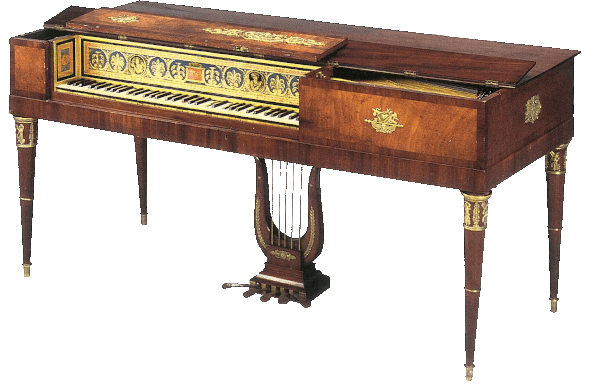
that belonged to Letizia Bonaparte
A new era begins
On April 14th 1829, Ignace Pleyel’s health began to degrade. The Pleyel father and son team settled succession matters and, with their faithful friend and renowned pianist Friedrich Kalkbrenner, founded "Ignace Pleyel and Company", which manufactured, sold and rented pianos. A second area concentrating only on music publishing was also established.
From that date, Kalkbrenner was financially associated with all operations conducted by the Pleyel Company until his death in 1849. These operations involved the purchase of land in Rue Cadet and Rue Rochechouart, construction of buildings, development of concert halls and so on: a new era began.
The ambassador of prestige
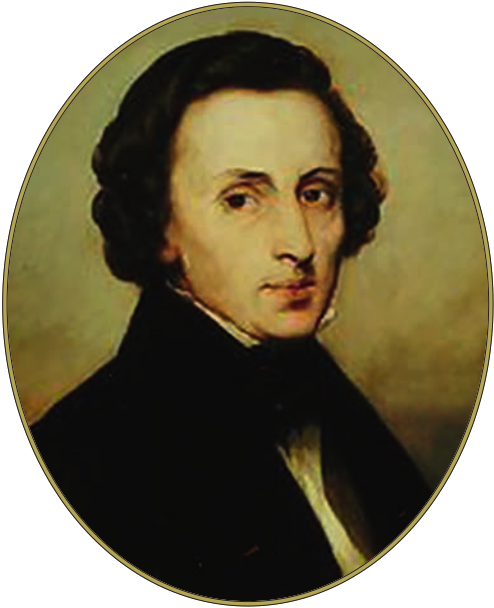
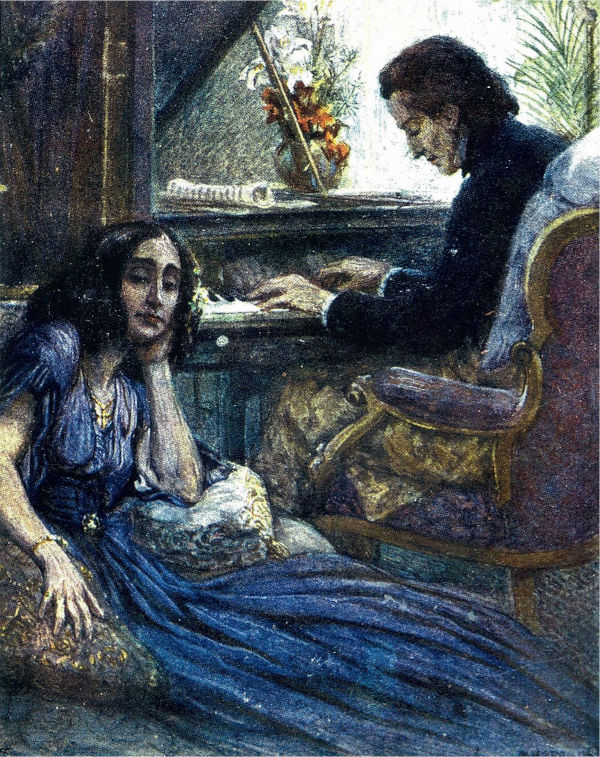
A great love story !
The artists, the best promotion for the brand
In this first half of the 19th century, Parisian musical life was in full swing. On January 1st 1830, Camille Pleyel organised the first public concert played on a Pleyel piano, ushering in what would become a custom: performing in public concerts on the company’s pianos. This ability to surround itself with artists, discovering talents and having them play its instruments is one of the characteristics of the Pleyel Company. Camille regarded musical events where the public could appreciate and judge the sound qualities of the instruments he sold as complementary to his industry.
The first concert halls in the world
In 1830, there were not any concert halls in the strict sense of the word, but more premises scraped together for this purpose. Quickly, these halls took on the appellation of "salons" borrowing from the literary salons of the Age of Enlightenment. It is in this context that Camille inaugurated his famous salons, located at 9 Rue Cadet, on January 1st 1830. They were to become a centre of Parisian musical life, where many virtuosos would be heard for the first time. Camille opened his doors to foreign artists visiting Paris: Cramer, Steibelt, Moscheles, Hummel and John Field. The salons of Rue Cadet prefigured what was to later become the first auditorium in the world dedicated to music. Located at 22 Rue Rochechouart and financed through the sale of the musical publications business, it boasted 550 seats. This undeniable link between Pleyel and high-quality concerts culminated in the opening of the legendary Salle Pleyel in October 1927 at Rue du Faubourg Saint- Honoré. This temple of classical music and jazz has hosted the greatest artists in the world for many years.
1831: A turning point in the life of Camille
The year 1831 marked a turning point in the life of Camille. On November 17th, Ignace Pleyel passed away, leaving behind the work of a major composer.
He was buried in Père Lachaise cemetery in Paris. Shortly before the death of his father, Camille married Marie Mock, who had previously been engaged to Berlioz. This concert pianist, accomplished virtuoso and famous throughout Europe, opened the doors of romantic salons to him. Following these changes, a new era began. Particularly attentive to artistic undercurrents, the young man loved to surprise and stand out from the classicism of his competitors. Thus, on February 26 th 1832 in the salons of Rue Cadet in Paris he organised the first concert of Frederic Chopin.
Pleyel and Chopin, inseparable
Camille Pleyel met Frédéric Chopin in the autumn of 1831 and in the Pleyel salons of his friend Camille, he gave his first concert on February 26th 1832. Before an audience of great Parisian pianists and music journalists, his success was immediate. His success continued until his death, but Chopin remained faithful to his friend Camille and to Pleyel pianos, whose touch married perfectly with Chopin’s playing, sometimes airy and refined and sometimes of measured violence. "When I feel in good form and strong enough to find my own sound, I need a Pleyel piano," Chopin liked to repeat. Camille became Chopin’s appointed provider, who gave in return all his Parisian public concerts in the Pleyel salons. He packed the house until his very last performance, a few months before his death in 1849.
Worldwide success
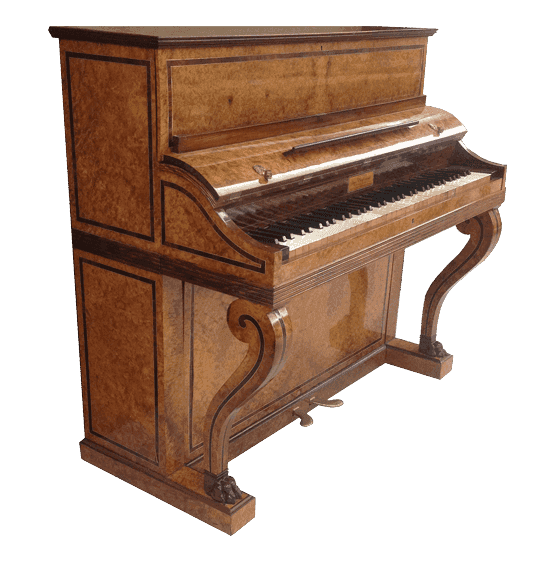
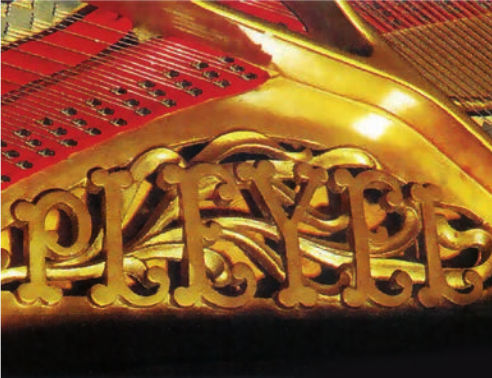
Continuous improvement of pianos
Camille intended to offer musicians a concert hall worthy of the name, but he continued in parallel to pay great attention to improving the instruments he produced.
He was the first to dare to use a metal frame for his pianos.
He gradually transformed the piano to meet the new demands of composers.
For powerful and rich sound, essential for some romantic works, he chose to place iron soundboard braces in grand pianos, which by their better resistance offered greater volume.
He also gave the keyboard perfect equality.
Camille never ceased to file patents.
He introduced the upright piano in France and perfected its production by inventing the "extended" sound.
Pianos for all
In 1838, he put on sale a baby grand piano of which the sound and timbre were comparable to larger models.
Anxious to allow everyone to work on a Pleyel piano, he proposed, as of 1839, a square study piano with two sets of strings and six octaves of excellent quality, very solidly built and at a very affordable price.
Aware of entering a decisive period for his company in severe competition with Erard, Camille launched his small upright pianos, the famous pianinos.
In 1855, the workshops employed 350 workers and produced 1,400 pianos a year.
Conquering the world
From 1830-1835, Camille was looking to expand his piano manufacturing. To do so, he aimed to win over new customers by trying the international market, so far dominated by the English.
Seeing a possible outlet for his business, he was particularly attentive to the manufacture of instruments for foreign countries, adapting and modifying their construction according to the climatic conditions to which they could be subject.
Very quickly, his efforts paid off. A newspaper of the time quoted that Pleyel pianos were not only in major cities in Europe, but also in New Orleans, Colombia, Chile, Peru, Brazil, India and even Australia.
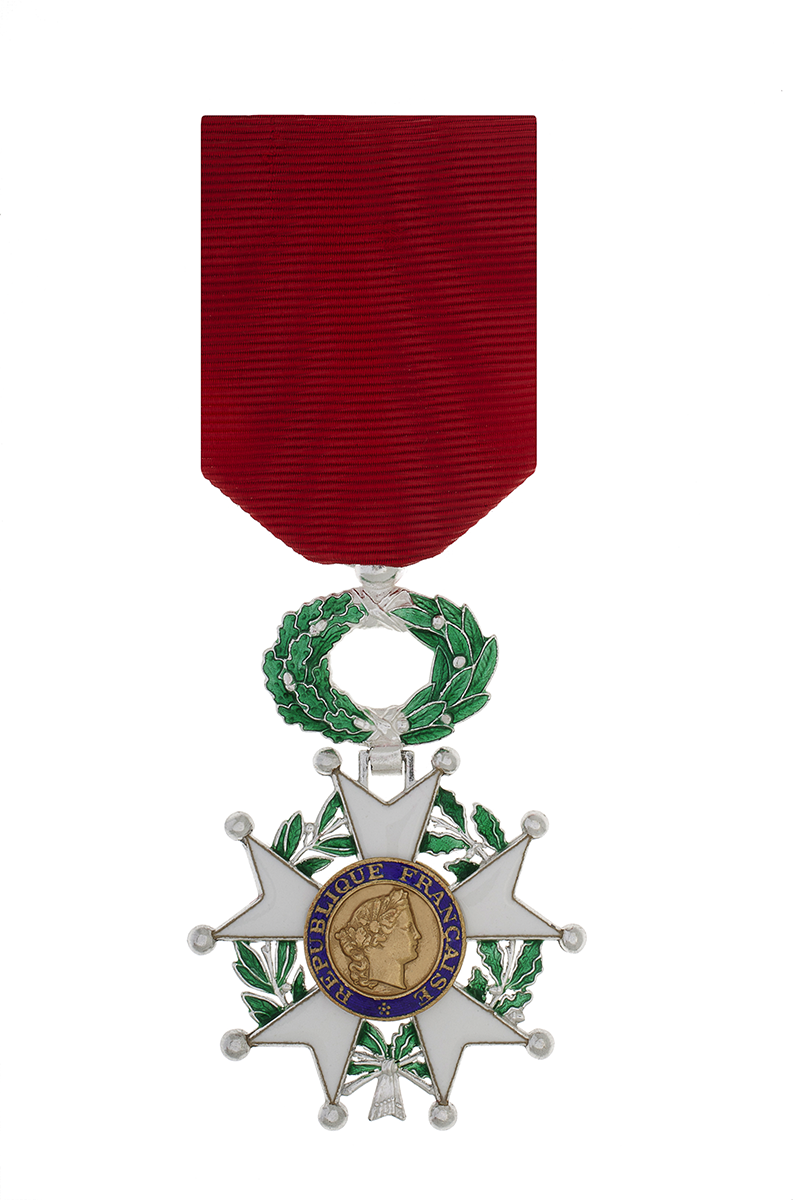
Recognition of his peers
Some thoughts recorded in 1830 in la Gazette musicale testified to the progress of research and discoveries from the Pleyel Company at that time: "The reputation of Mr Pleyel’s pianos is now made worldwide and among artists. In regard to sound quality, these instruments leave nothing to be desired and even seem to outweigh English pianos, which have long been the manufacturing model. Mr Pleyel yet again found ways to improve their products by changing the keyboard system and ensuring their lightness.
In this period, the Pleyel Company received multiple awards including gold medals at the National Exhibition in Paris. Camille was raised to the status of Knight of the Legion of Honour in 1834.
On May 4th 1855, Camille died "in the middle of a true industrial success", wrote the newspaper L’Illustration. He received his latest award posthumously: a medal of honour at the Universal Exposition in Paris in 1855.
Industrialization
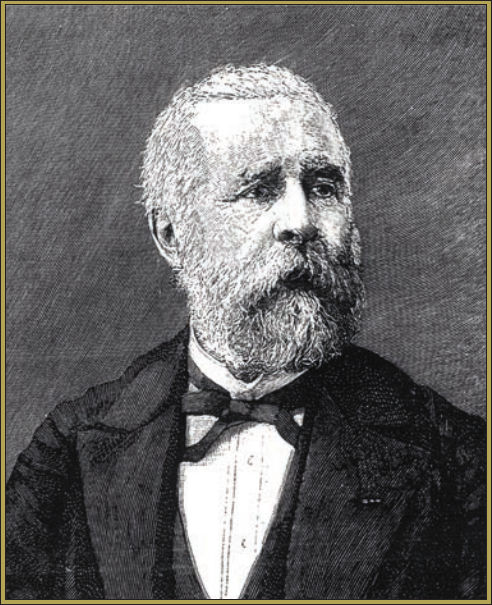
An exceptional entrepreneur
Associated with Camille Pleyel in 1853, Auguste Wolff became head of the company in 1855. Like the Pleyels, he was also from a family of musicians. Born in Paris in 1821, Wolff, a talented composer and an excellent musician, was awarded first prize in piano at the Paris Music Conservatory in 1839.
He had active entrepreneurial skills that allowed him to extend the work of Pleyel. He became an exceptional piano maker and contributed greatly to the development of the company, especially by the ingenuity and the quality of his innovations.
A large factory in Saint-Denis
In 1865, to support the resounding commercial development of the company, the Pleyel manufacturing workshops were transferred to Saint-Denis. A large factory was erected on the 55,000 square meter site. It included workshops equipped with steam engines, large areas for storing equipment from around the world and offices for management.
Advances in industrial technology with the development of steam and dynamo-electric engines allowed the production of a number of units that had never been achieved before, with a peak in 1866, the year during which 3,000 pianos left the factory.
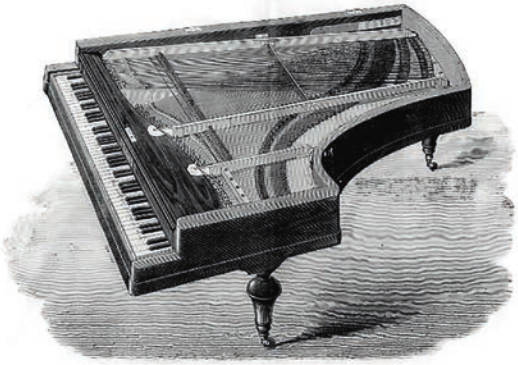
iron soundboard brassed and pinboard
From piano manufacturer to industrialist
Auguste Wolff knew how to harness the great industrial development and adapted the mechanisation of his tools: the factory was equipped with heating pipes, compressed air and steam-powered boilers and an autonomous power station. Wolff showed rigour, but also proved to be a humanist and a visionary.
Recognising the difficulty of managing a major payroll for the period (up to 800 people worked on this site), Wolff was also interested in new working conditions inherent to technical progress and was able to put in place innovative social measures.
A gigantic research lab
In this modern factory, larger warehouses and research laboratories also contributed to the quality of instruments leaving the workshops. Wood, metal, felt and varnish were tested within the factory. Wolff ensured that the metals used on his pianos were shaped and tested on site. The careful selection of raw materials was a prerequisite for good manufacturing of the series.
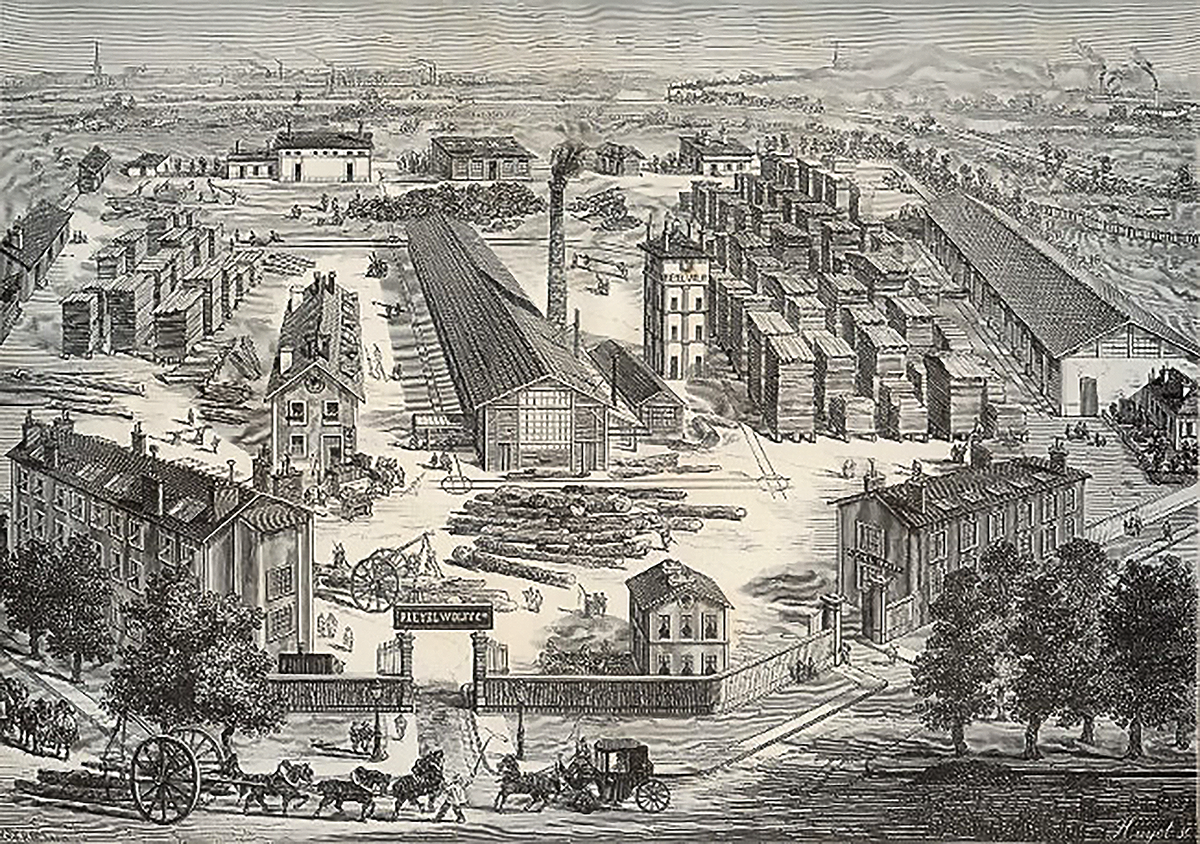
An unprecedented technicality
Technical progress, the quality of the plant and everybody’s enthusiasm meant that the pianos made never ceased to improve. The various innovations were guided by the final quality, reliability and especially the piano sound that emanated. The innovations of the mid-19th century included: the pedal piano (adaptation of pedals that were found on the organs), the transposing keyboard, independent and adaptable to all pianos (mobile keyboard that is superimposed on the ordinary keyboard), the tonal pedal on the piano, the improved double escapement... Particular attention was paid to the keyboard for accuracy, sensitivity and speed on each attack. The use of parallel and crossed strings, attention to tensions and a careful selection of materials gave more strength and lightness to the wooden structures. Wolff replaced the wooden frame with a cast iron frame in order to give a fine and distinguished sound to the pianos. Crowning all these innovations, the Pleyel Company received a medal at the London World Exhibition in 1862.
The golden age
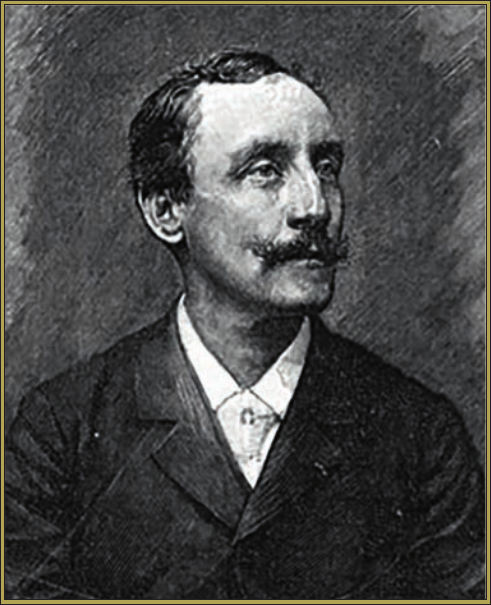
Pleyel, the "French" sound
Following the disappearance of Auguste Wolff, Gustave Lyon took charge of the Pleyel Company. Born in 1857, Lyon was an alumnus of the Ecole Polytechnique and held an engineering degree from the Ecole de Mines. Also an accomplished musician, he used his scientific knowledge to improve the quality of pianos and deepen the acoustic secrets.
One of his first innovations was to make a stainless steel metal frame for pianos - the famous "Pleyel steel", a specific less carburised metal cast in one piece and not assembled.
His inventions earned him an honorary award at the 1889 Paris Universal Exhibition when the Pleyel Company produced its 100,000 th piano. An exceptional title of glory since Pleyel was the first piano manufacturer in the world to reach this figure.
At the turn of the new century, the Pleyel brand had its fans. It was indeed Lyon that led pianists to adopt the famous Pleyel sound, embodying "the French sound" with its romantic colouristic characteristics. Pleyel pianos had lightness, roundness, a powerful bass and an amazing sparkling treble, which gave them a real harmony. The sound of Pleyel pianos seduced the whole young generation composed mainly of Russian composers.
In 1907, Gustave Lyon organised a concert in their honour at the Salle Pleyel in Rue de Rochechouart. Camille Saint-Saëns, launched by the Pleyel Company when he was 11 years old, organised the event that brought together prestigious pianists: Rimsky-Korsakov, Rachmaninov and Wanda Landowska.
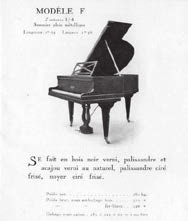
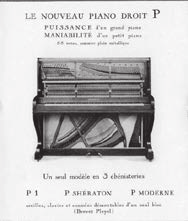
P and F models
The climax of the Pleyel Company was in the years 1925-1930 when prestigious models were created. Lyon is in fact the inventor of the famous upright piano called "model P" that the specialist Jean-Jacques Trinques called "the king of uprights", and the mythical "model F", a baby grand piano based on the model "3a" mentioned above.
Greatness...

The Salle Pleyel
In addition to manufacturing pianos, Gustave Lyon was fascinated by the acoustics of concert halls. At this time the sound was more a matter of art than a science. Lyon became an acoustics specialist of auditoriums and his recommendations were regularly followed by architects.
The construction of the Salle Pleyel at Rue du Faubourg Saint-Honoré in 1927 marked the apotheosis of this dynasty.
This imposing auditorium of music in Paris presented at its opening a capacity of 2,600 seats.
At that time, the Salle Pleyel was one of the three most prestigious auditoriums in the world, next to the Concertgebouw in Amsterdam and Carnegie Hall in New York.
...and decadence
The crisis of 1929
But the crisis of 1929 will announce, with a bankruptcy filing in 1933, a long decadence which sadly ended in 2013 with the closure of the production workshop in Saint Denis, the last desperate survival of a past greatness, which produced only a few examples for a rich clientele more interested in unique pieces by famous famous designers than real instruments.



